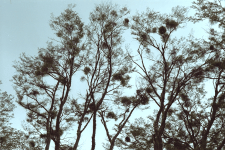 Misteltoe clumps in the high deciduous beech trees
Misteltoe clumps in the high deciduous beech trees
 Misteltoe clumps in the high deciduous beech trees
Misteltoe clumps in the high deciduous beech trees
Paola also told us about the "Indian Bread" parasite that grows on the Beech trees, which the native people used to eat. These round white mushroom-like parasites grow around the branch of a tree. Eventually, the tree reacts by growing a scar-like spiked growth through the branch, making it look like a hardened flower when the parasite drops off.
Further into the park, we visited a glacial lake (freshwater!) nestled between the mountains. Very spectacular panorama! The green water in the lake was very agitated by the high winds, and the waves were about two feet high. They broke against the shore violently. There was a very narrow (three feet at most) steep beach made of charcoal-colored sand and smooth, flat, round stones. Not as dark as volcanic rock usually appears, but similar in appearance.
A glacial inland lake
On our way (walking) to a small campground and coffee shop, we saw a large red-headed woodpecker. It had a large black body and a very red head. It was pecking away at a tree, then at a fallen log on the ground. We also saw two very large rabbits hopping around.
I took a picture of Laguna Verde, the Green Lagoon, with mountains in the background. Truly a beautiful place.
Paola spoke to us about the introduction of the beaver to Tierra del Feugo. They were brought here from Canada with the intention to start a fur industry here. When the project didn't pan out, the beavers were left free. Now, their dams are killing large portions of the forests in this park, and elsewhere. We saw swampy-like areas with whitened, dead trees, drowned in the excess water above the dams. There are no natural predators for the beavers, such as the lynx.